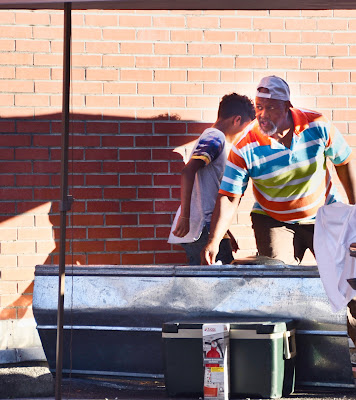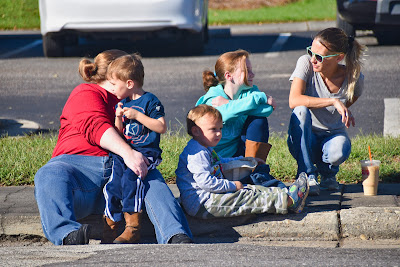Today is All Hallows Eve, or as we know it Halloween, or Hallowe'en as it was spelled in the early part of the 20th century. It appears from newspaper accounts that in those early years of the last century, most of the Halloween celebrations were geared toward adults rather than children.
In 1901, The County Record noted that several young ladies in town celebrated Halloween by having their futures told by a Gypsy fortuneteller. It was not uncommon for bands of Gypsies to camp near town when they were in the area, so it is possible that such a group was in the vicinity in October 1901. The next year, the ladies of Williamsburg Presbyterian Church sponsored a "Hallowe'en entertainment" at the courthouse. They, too, had a fortuneteller, although probably not a Gypsy, and a witches' cauldron from which punch was served. Keen competition was reported in a cakewalk which was won by Lucius Montgomery and Lula Strong. The ladies raised $60 for the church.
The Daughters of the Confederacy sponsored a Halloween party in the billiards room at the Kellahan Hotel in 1908 to raise funds for the Confederate Monument. This party drew a very slim crowd, and the ladies raised only around $30. The newspaper reported that Eunice Kennedy was a "charming little Hallowe'en witch." Guests who visited her "tent" were given a picture of their future lord or lady and a written sketch of their happiness or unhappiness in marriage. According to the paper, Belle Ervin and Helen Scott were in charge of a gallery of famous painting, representing an amusing pun or a ridiculous object which guests were supposed to guess. Homemade candy, tea, coffee, hot chocolate, and ice cream were for sale, and Martha Scott and Mamie Brockington were in charge of a supper of turkey, chicken, rice, and pickles.
The Central Warehouse on Hampton Avenue was the venue for a Halloween party in 1913, sponsored by the Epworth League of Kingstree. Costumes of witches, goblins and ghosts were extremely well done, and the warehouse, decorated with pumpkins, autumn leaves, and black cats, cast an eerie spell.
The Brooks Street home of Mr. and Mrs. A.C. Swails was the gathering place for a large group of young people on Halloween 1920. The County Record noted that they "paraded the streets and made merry, after which they again assembled at the Swails' home and enjoyed contests for the remainder of the evening,"
In 1922, Kingstree appears to have celebrated Halloween for almost a week, with more involvement from youngsters than previously shown. The partying began on Monday, October 30, when the Boy Scouts had a party at their hall in the Gourdin Building on Main Street. Each Scout was allowed to invite one girl, and the evening was spent bobbing for apples, running past apples hanging on strings, trying to take a bite from them as they ran, and enjoying punch and fruit. The next day, on Halloween, Leila Brown's Sunday School Class was invited to her home for a costume party, with each guest wearing a mask. The house was decorated with autumn leaves, owls, black cats, and witches. Punch was served from a big, black, three-legged cauldron with a long-handled dipper and tin cups. The guests also enjoyed popcorn, fruit, and nuts. That same evening, the Baptist Young People's Union was invited a party at the home of Madeline Miller. The 35 in attendance were served a witch's cake in which a dime and a penny had been hidden. The day after Halloween found the Junior Christian Endeavor group attending a party in which the rooms were darkened and decorated with Halloween-themed favors. They bobbed for apples and played other games.
A big bonfire was the major attraction at a party for the sixth grade in 1926. The party was held at the home of Mrs. Louise Gilland, and the guests all arrived in fancy costumes.
During the late 1920s and early 1930s, many youngsters who had birthdays in October celebrated with Halloween-themed birthday parties. In 1931, Mary Catherine Epps' music students gave a Halloween recital in which they played and sang Halloween songs and enjoyed Halloween-themed refreshments.
By the late 1940s, the Parent Teacher Association (PTA) of the school began sponsoring a costume parade for pre-school and elementary school children, led by the marching band. And in the 1950s, the Halloween parade and carnival was taken over by the senior class of Kingstree High as a service project. The parade route ran from the new elementary school on Academy Street to the High School auditorium on Third Ave. There were 150 participants in the 1953 Halloween parade.
Photos taken in different years and at various locations in Kingstree.
One of the most interesting events to take place in Kingstree on October 31 had nothing to do with Halloween. On that date in 1900, South Carolina Governor Miles McSweeney came to town to perform a double marriage ceremony. Sisters Esther and Lillie Benjamin had planned a double wedding. Esther was marrying Dr. W.S. Lynch, while Lillie was to marry Hoxie G. Askins, Esq. The brides were Jewish, while their intendeds were not. They decided that they wanted neither a rabbi nor a Christian minister to perform the ceremony, but the governor was acceptable to all parties.
As it happened, that week was also State Fair week in Columbia, and Governor McSweeney had responsibilities at the fair that day. He asked if the wedding parties could come to him. However, that was apparently not acceptable, and somehow he was able to rearrange his schedule in order to travel to Kingstree to perform the ceremony, which was held at the home of Mary and Louis Jacobs on Main Street (where Hardee's is today). Louis Jacobs escorted both brides down the aisle.
C.W. Wolfe, owner and editor of The County Record, made much over the fact that the governor accidentally broke a glass during the wedding. Wolfe noted that this was a "singular coincidence" as it is traditional to break a glass during a Jewish wedding ceremony.





































